MedioVis 2.0

Duration
01.07.2008 - 31.10.2010
Members
Heilig, Demarmels, Huber, Rexhausen, Jetter, Runge, Gerken, König, Grün, Reiterer
Introduction
The MedioVis 2.0 project aims at providing natural user interfaces for information seeking and exploration in multimedia libraries.
Such knowledge work is increasingly demanding because of the growing size, heterogeneity, and dimensionality of today’s information spaces. Furthermore knowledge work is ill-defined and involves individual and creative workflows that involve multifaceted characteristics like diverse activities, locations, environments and social contexts.
Although it is important to find solutions to specific aspects of knowledge work, e.g., information seeking, information management, media warehouses, our design approach tries to support the entire workflow with a holistic Knowledge Media Workbench that is showcased in the context of digital libraries.
External Page
To view this content (source: www.xyz.de ), please click on Accept. We would like to point out that by accepting this iframe, data could be transmitted to third parties or cookies may be stored.
You can find more information on our privacy policy .
Project Description
Scenario 1
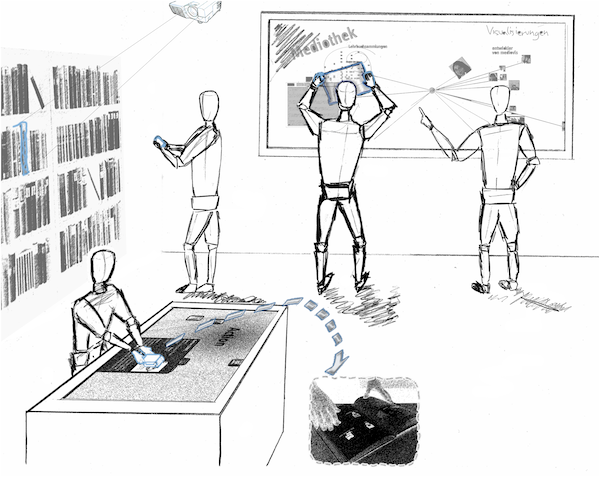
With this scenario we want to introduce our vision of the Blended Library. With new interactive devices and visualizations, as well as the blending of real-world objects into the digital information space, knowledge workers will gain novel prospects in research and knowledge transfer.
The characters of our story will be shown in different real life situations during their work with the library of the future. We will be able to see how they are using tools designed for the various physical and social environments.
Scenario 2

During the media science seminar "Comic Book Adoptions" the professor gives the assignment to write an essay on the analysis of a specific movie character.
A zoomable information landscape enables the students to explore interesting movies. By zooming onto a digital movie object more information and functionalities become accessible.
Scenario 3
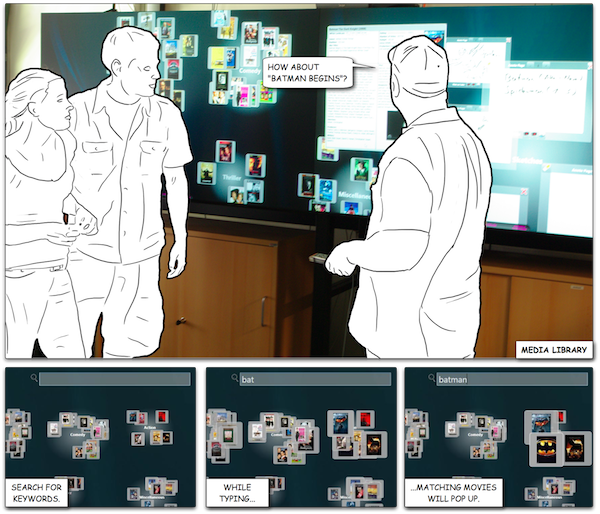
To discuss first ideas the students meet their tutor in front of the public wall display installed in the university's media library.
Scenario 4

At home further investigations are carried out on the personal computer.
The use of different visualizations helps gaining a deeper insight into the topic.
Scenario 5
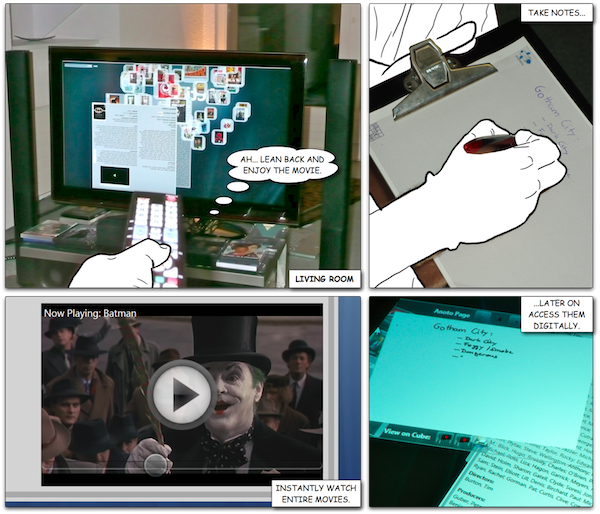
To watch actual movies the home cinema system still suits best.
Annotations made during the movie are blended into the digital workspace for later use.
Scenario 6

Devices and tools in the library provide an optimal environment to facilitate collaborative work.
As an example, the keywords of a search are embodied by tangible user interface elements. This encourages students to analyze the data space together in a natural manner.
Scenario 7
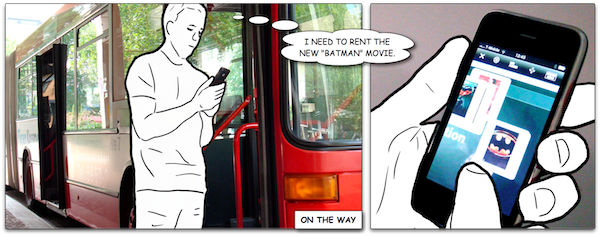
Many situations in the daily routine reveal the demand for mobile devices to access the Blended Library.
Scenario 8
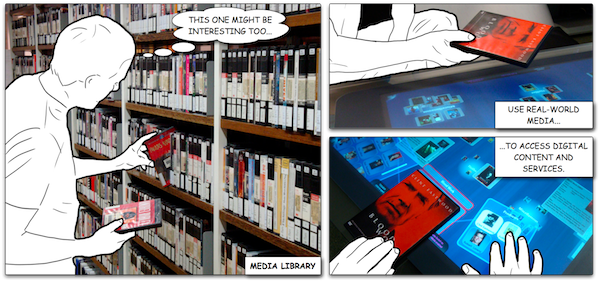
The physical library with its spatial literacy and its tangible information objects will always maintain its value. With our vision of the Blended Library this natural fundament will be improved by combining the real and the virtual.
Prototype
Interact

The fundamental visualization and interaction paradigm of MedioVis 2.0 is the idea of a Zoomable Object-Oriented Information Landscape ZOIL.
Within this paradigm, an information landscape of virtually infinite size serves as basic starting point for exploration of the information space. MedioVis 2.0 arranges each media object, corresponding to its primary genre on the landscape. Users are able to navigate in this landscape with zooming and panning operations. This navigation technique takes advantage of the human abilities of visual-spatial orientation and remembering visual “landmarks”. By employing this concept, users are able to utilize natural and intuitive operations as search strategy in media collections.
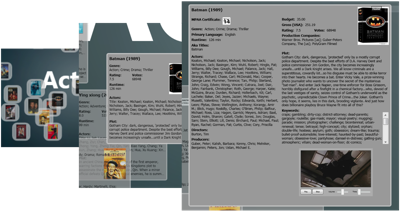
The more the user zooms into the content, the more details and functionalities are revealed. This is done by a “semantic zooming” approach. Thus, the available functionalities such as playing a video or accessing a website are always coupled with the information object itself, as it is proposed by object-oriented user interfaces.
Search & Explore

Analytical search methods are supported by MedioVis 2.0 to formulate specific information needs.
Example: Users are able to enter text queries into a search field on the upper right corner of the screen. With each key press, the visual representation of matching objects expands.
We applied the concept of Dynamic Queries and Sensitivity for direct highlighting of objects, which still match the current query instead of removing all non matching objects. With this technique, the attention of the user is automatically directed towards media objects of current interest.
Visualize
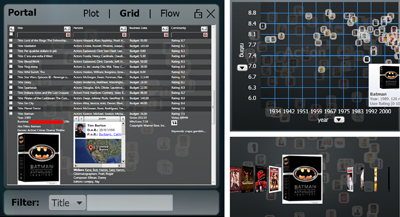
To provide different views on the information space we use the concept of portals that offer various visualizations. Portals provide a supplementary way of exploration.
Example: By selecting an arbitrary region of the information landscape via a bounding box, the user creates a portal, providing a special view on the underlying media objects.Within portals, MedioVis 2.0 offers multiple visualization techniques – for understanding, filtering and querying – ranging from a rapid serial visual presentation over a scatter plot visualization called HyperScatter to a table-based visualization called HyperGrid.
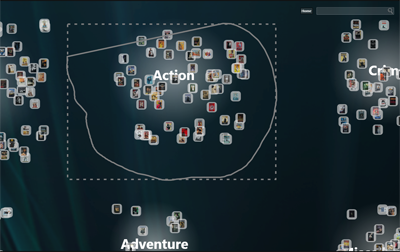
Portals provide visualization-independent filter mechanisms. These filters are preserved even if the user switches the visualization. By moving and scaling portals in the landscape, MedioVis 2.0 allows to visually formulate complex queries in a direct-manipulative manner as proposes with the concept of magic lenses.
Personalize
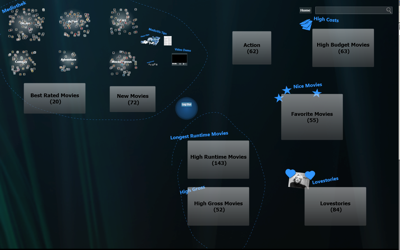
Personalization allows the user to access his individual region of the information landscape from everywhere. To retain the state of a portal – with its filters and visualizations – for later use, MedioVis 2.0 provides the possibility to “lock” and assign a name to portals. Furthermore, users can reach their personal region of the information landscape by logging in. Drag & drop operations allow adding previously “locked” portals or single media objects into this region. A search task is therefore no longer a transient action that is often difficult to repeat but rather a persistent artifact of a creative work process. Furthermore, the personal region can be organized individually by annotating, labeling and arranging objects the way that fits best to the user's needs.
Experience
An additional design goal of MedioVis 2.0 is to unite all techniques and features described above in one consistent and positive user experience. Besides a satisfying usability we also considered several soft factors like joy of use or attractive visual design.The design of MedioVis 2.0 should encourage the explorative and playful discovery of information objects or novel functionalities during the overall navigation process in the information landscape.
Use It
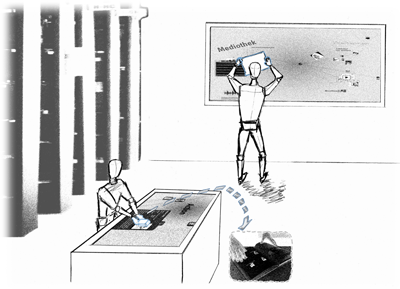
Creative information work is a complex activity, usually executed in varying situations and environments.Therefore, one goal of MedioVis 2.0 is to develop an interface concept suitable for many different devices, which unifies all kinds of content and functionality with one consistent interaction model, while leaving the user the possibilities to establish own workflows, data structures or views on the information space.
Due to the nature of zoomable user interfaces, information presentation scales implicitly to a certain extent to different display sizes and is therefore applicable on very different hardware platforms, varying from mobile devices over desktop PCs up to large, high resolution displays. The Media Room offers good opportunities to simulate public walls, tabletop terminals, the work with mobile devices and much more.
Videos
External Page
To view this content (source: www.xyz.de ), please click on Accept. We would like to point out that by accepting this iframe, data could be transmitted to third parties or cookies may be stored.
You can find more information on our privacy policy .
External Page
To view this content (source: www.xyz.de ), please click on Accept. We would like to point out that by accepting this iframe, data could be transmitted to third parties or cookies may be stored.
You can find more information on our privacy policy .
External Page
To view this content (source: www.xyz.de ), please click on Accept. We would like to point out that by accepting this iframe, data could be transmitted to third parties or cookies may be stored.
You can find more information on our privacy policy .
MedioVis 1
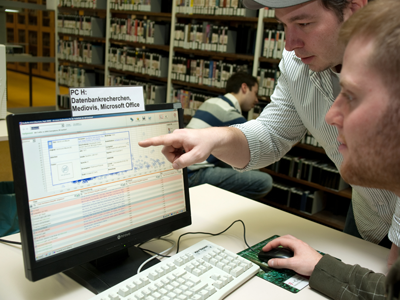
MedioVis 1 is concerned with the user-centered development of a next generation visual information-seeking system for novice and non-expert users. A central design goal of the MedioVis 1 interface is to offer interaction focussed support for realistic human search behavior.
Since 2004 MedioVis 1 has been accessible on more than 150 workstations in the library of the University of Konstanz. It allows users an alternative approach, alongside the standard online catalog system, to search through more than 70,000 multimedia objects such as movies or documentaries. More information is available on the MedioVis 1 project website.
Related Projects
Publication list




